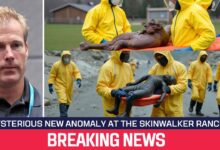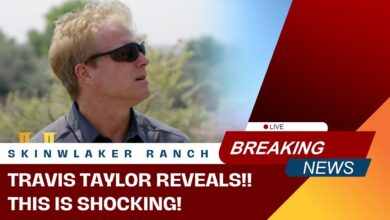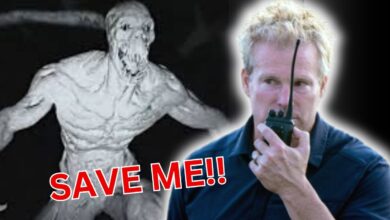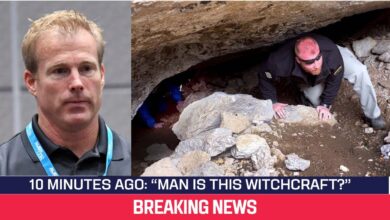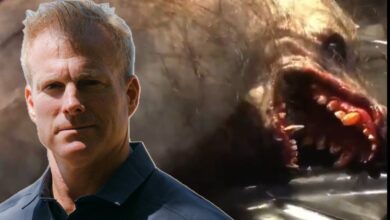Travis Taylor: This is BIGGEST ALIEN DISCOVERY at Skinwalker Ranch | The Secret Of Skinwalker Ranch
Travis Taylor: This is BIGGEST ALIEN DISCOVERY at Skinwalker Ranch | The Secret Of Skinwalker Ranch

For decades, Utah’s Skinwalker Ranch has remained a crucible of the unexplained, a place where folklore, fear, and science collide. Strange lights have danced across its skies. Electromagnetic fields have surged without warning. Cattle have been found mutilated with surgical precision, and craft, unlike anything known to modern technology, have been reported slipping in and out of view. Each generation of witnesses has added to the legend. Yet, the ranch has never ceased to surprise. During a recent investigation, however, it unveiled something even more startling, an unidentified aerial phenomenon that appeared to crash directly into the mesa itself.
The impact was not accompanied by fire, smoke, or debris in the conventional sense. Instead, it was as though the object had melted into the rock, swallowed whole by the ancient formation. Even for seasoned investigators, men and women hardened by years of exposure to anomalies, the event defied logic. Scientists, military veterans, and observers accustomed to the extraordinary were left speechless. Their instruments recording data that resisted explanation. This was no casual sighting.
The experiment that precipitated the event was carefully staged. A fusion of scientific rigor, and state-of-the-art technology. Instruments tracked fluctuations in radiation, magnetic anomalies, and aerial trajectories with precision. High-speed cameras and radar systems monitored the skies, ensuring nothing could slip past unnoticed. Yet, even under this scrutiny, the phenomenon unfolded in ways that seemed designed to mock human understanding.
Adding to the gravity of the moment were the guests who bore witness, Ryan Graves, former Navy pilot and congressional UAP whistleblower, whose testimony has helped shift national conversation on unidentified phenomena, and J. Stratton, once the head of the Pentagon’s UAP task force, their presence underscored the significance of the experiment. What occurred on that day at Skinwalker Ranch was not just spectacle, but an event carrying implications far beyond the ranch’s borders. An encounter that reached into the corridors of power and science alike. Together, the group bore witness to events that strained the very boundaries of conventional explanation.
The Knight’s experiment carried with it a singular but audacious objective, to lure the hidden forces of the ranch into making themselves known. The idea was simple in principle, but dangerous in implication. If the anomalies above the property truly reacted to provocation, then the team would meet them head-on with science. Dr. Travis Taylor and his colleagues had devised the test with precision. Working in collaboration with LLC Precision, they orchestrated a synchronized launch of 16 rockets across two of the ranch’s most infamous zones, the Enigmatic Triangle and the brooding expanse of the East Field.
These were not fireworks for spectacle, nor hollow demonstrations of technology. Each rocket carried lights and parachutes, transforming them into airborne markers designed to trace their movements against the night sky. Their arcs would serve a deeper purpose, probing the massive cone-shaped anomaly the team had previously identified hovering above the ranch, an invisible volume of distorted space that defied explanation. The hope was not merely to graze its edges, but to disrupt it, to reveal the contours of something unseen yet undeniably present.
The preparations for the launch were exhaustive. Surveillance coverage extended across every corner of the property. A law equipped drone patrolled the skies with silent efficiency. Its sensors sweeping for anomalies invisible to the human eye. Groundbased cameras, radar arrays, and electromagnetic detectors stood ready, forming a net of observation that no anomaly, no matter how elusive, could slip through unnoticed. The scene was one of scientific theater, a convergence of cuttingedge instrumentation and primal anticipation, as though the team were preparing to interrogate the heavens themselves.
Every detail seemed magnified under the desert night. The stillness of the air before ignition. The nervous glances exchanged between veterans and scientists. The way the mesa loomed like a silent sentinel, waiting to judge the outcome. It was more than an experiment. It was a dare. A challenge thrown at forces that had evaded humanity for centuries.
Thermal flare cameras captured the restless heat signatures above the ranch while Eric Bard’s imposing Kraken antenna array swept the air for telltale spikes of electromagnetic activity. Every instrument was tuned with surgical precision, yet the atmosphere bristled with an anticipation that no technology could quantify. Ryan Graves, drawing on years of Navy experience tracking elusive UAPs through the advanced atflare systems mounted on F-18 fighter jets, assumed responsibility for monitoring the thermal feed. His practice I scanned the glowing outlines for patterns that others might overlook, searching for disturbances that signaled something out of place.
The countdowns ticked away, measured and steady, until the silence of the Utah desert was broken by the sharp crack of ignition. Rockets roared skyward in synchronized succession, streaking into the night like incandescent spears. The east field launches arked gracefully overhead, their trails etching temporary scars of light against the canvas of stars. For a moment, everything seemed to unfold precisely as planned, orderly, measurable, predictable. But then the desert betrayed its secrets.
Almost immediately the parachutes began to unfurl, and with them came a chain of impossibilities. Where simple physics demanded they drift earth in uniform descent, they instead twisted and broke formation. One parachute tore sharply north, another veered inexplicably south, though both had been deployed mere yards apart. The contrast was not subtle. It was violent, deliberate, as if some unseen current had gripped them and forced them apart.
The anomaly silenced even the most skeptical observers. Wind could not account for such divergence. Not when local meteorological data confirmed calm skies. Engineers and seasoned rocketeers alike shook their heads. The lines of confusion etched deeply across their faces. This was not turbulence. This was not chance. It was as though the rockets had trespassed into a space governed by rules entirely foreign. Their descent, manipulated by invisible hands.
The night’s controlled experiment had shifted into something far stranger, and every eye, human and mechanical alike, was fixed upward, waiting for what would follow. Something unseen was interfering. The parachutes drifting in impossible contradictory paths weren’t just random deviations. They were a violation of natural law. In calm desert air with no sudden wind gusts, two parachutes only yards apart had been pulled in opposite directions, as if invisible currents were carving separate channels through the sky.
For the seasoned rocketeers, men who had spent decades launching precision rockets in every kind of condition, the sight was staggering. One of them finally muttered in disbelief, his words hanging heavy in the cool night air. We’ve been doing this for 30 years, and only here do we see this kind of behavior. At Skinwalker Ranch, the ordinary rules of physics seemed to warp, twisting into something alien. The rockets hadn’t entered a neutral sky. They had entered a domain where unseen forces contested every trajectory, as if the very atmosphere were alive and resisting their intrusion.
As one rocket’s trail arked downward in a brilliant streak of light, Ericb’s voice cut through the comms with sudden urgency, his cracken antenna array had locked onto something impossible to ignore, a signal, sharp, consistent, rhythmic, pulsing at 1.6 GHz. The tone repeated with mechanical precision, originating from the direction of the infamous triangle and extending like an invisible beam toward the ranch’s southern fence line. The frequency range electrified the team. 1.6 JC is no trivial background noise. It sits within a band used for advanced satellite communications, classified radar systems, and aerospace technologies that don’t belong in a Utah pasture. Yet, the spectrum analysis left no doubt. Something in that barren stretch of desert was transmitting with clarity, as if awaiting their experiment.
Even more disturbing was the alignment. The signal was unnervingly precise, mapped directly along the flight paths of the rockets. It was as if their launches had tripped an unseen switch. Something, whether a system, an intelligence, or a machine, had activated in response. Graves with years of Navy experience behind him, immediately recognized the cadence of threat detection systems. The steady pulse reminded him of radar locks and surveillance sweeps used by adversarial militaries. It gave him the sense that their experiment wasn’t just being observed, it was being targeted. To him, this was the same invisible tension that pilots felt in hostile skies when an unseen adversary painted their aircraft with radar, an invisible finger pressing against their presence.
Stratton, however, filtered the data through another lens. Having led the Pentagon’s UAP task force, he recognized the same unnerving patterns that surfaced in decades of military encounter reports. The timing, the signal strength, the correlation with the rockets, these weren’t coincidences. To him, it echoed stories of technology lying dormant until provoked, reactive, and watchful as though waiting for a particular threshold to be crossed.
The desert night grew heavier, the silence between transmissions thick with unease. The team felt it in their bones. They had not just lit up the sky with rockets. They had drawn the attention of something hidden, something that did not wish to remain hidden. Whether it was a machine buried within the mesa, a surveillance system from elsewhere, or something altogether stranger, the message was clear. They had been noticed.
The true breakthrough of the night came during the second round of launches. The rockets ignited with a roar, streaking upward in brilliant arcs, their exhaust trails glowing against the black canvas of the Utah sky. As they rose over the triangle, every eye in the command center shifted to the banks of monitors. That was when Graves, his focus honed by years of scanning skies from the cockpit of an FA18, leaned toward the thermal display.
At first, it was a flicker in the feed, almost dismissed as a glitch or atmospheric distortion. But then it sharpened, an unmistakable heat signature structured and distinct, emerging in the midst of cloud cover 5 mi distant. It was not drifting with the wind like a natural anomaly. It was moving fast, controlled. The outline pulsed against the cold background, maneuvering with precision that no conventional aircraft should be capable of.
The object descended abruptly, carving an impossible trajectory downward. Then, in a single fluid motion, it pivoted and made a hard turn, an action that would have shredded any known aircraft under those G forces. “That’s not natural movement,” Graves muttered under his breath, though the data spoke loudly enough on its own. The trajectory angled straight toward the mesa, the same looming ridge line where countless eyewitnesses over decades had reported luminous craft appearing and disappearing.
The command trailer grew tense. Every monitor flickered with feeds, every antenna and sensor strained for confirmation. Graves tracked the object as long as the thermal feed allowed. But then, as suddenly as it had appeared, the heat signature blinked out. Vanished. No lingering trace, no gradual fade. One instant there was something structured alive with motion and the next nothing but empty air.
Bard immediately checked the ADSB receiver system, a tool designed to track every commercial and private aircraft transponding within a 150 m radius. The display was clear, unambiguous, no returns, no squawks, no aircraft. The skies were officially empty. Whatever Graves had captured was not in the FAA registry, not a commercial jet, not a drone, not even a stealth craft running silent. It simply wasn’t there.
For the team, the implications were staggering. The object hadn’t simply crossed their skies. It had appeared to dive into the mesa itself, as though the sandstone ridge had swallowed it whole. Theories that had once seemed speculative, tunnels, caverns, hidden structures, perhaps even some form of portal, suddenly gained a chilling weight. Inside the trailer, silence pressed down on the investigators as they replayed the footage frame by frame. They knew what they had seen, a heat signature structured enough to defy coincidence, a movement profile that broke the limits of known aeronautics, an object that had seemingly vanished into the Earth itself.
Skinwalker Ranch had always hinted at being more than just a place of lights in the sky. Tonight, before their instruments and their trained eyes, it had given them a glimpse of something buried deep beneath the mesa, an entrance, a refuge, or a base of operations for whatever intelligence lingered here.
This was not the first time Skinwalker Ranch had revealed its secrets at the mesa. The Sandstone Ridge had long been a stage where the inexplicable played out. Earlier investigations had recorded glowing orbs plunging into its surface, as if the rock itself were permeable. Radar sweeps had shown blips darting across the screen only to vanish at its edge, leaving seasoned operators staring in disbelief. Even electronics, machines hardened against interference, had faltered when positioned directly overhead. The mesa was no passive landmark. It was a locust, a boundary, a place where phenomena converged.
What Graves tracked on the thermal display seemed to echo those earlier accounts with unnerving fidelity. The object descended in a controlled arc, then snapped eastward with sharp precision before dissolving into nothingness. Its behavior suggested more than random motion. There was intent, a pattern of maneuvering too deliberate to dismiss as mechanical error or chance.
For Travis Taylor, who had always sought to anchor his work in data and discipline, the moment broke through his usual composure. The sheer velocity of the descent, the abrupt pivot, the disappearance into the landscape, it all carried the hallmarks of intelligent control. This was not the lazy drift of a balloon or the erratic sputter of a misfiring drone. It was a craft or something like a craft executing movements that strained the limits of physics as humans understood them.
Skeptics might still protest, pointing to thermal anomalies, faulty sensors, or the possibility of experimental drones skirting FAA oversight. Yet, the team’s instruments told a different story. Bard’s ADSB system remained blank, a silent witness to the absence of any registered aircraft within 50 mi radius. By law, every civilian and commercial craft was required to broadcast its location and identity. This one did not. It was invisible to the world of conventional aviation, existing only as a phantom on their thermal sensors and in the eyes of those who watched.
The convergence was unmistakable. Again and again, the mesa had become the terminus of such sightings, as though it were not merely stone, but a threshold, an entry point into something hidden, buried, or shielded from ordinary perception. The night’s data only reinforced the suspicion the ranch was not just a site of transient aerial phenomena. It was a place where the unseen lingered, and where every probe into the sky risked stirring what resided beneath the earth.
The object stood out with thermal distinctiveness, burning bright against the cold backdrop of night. Unlike drifting debris or the faint traces of birds, its heat signature was undeniable, vivid, structured. It moved with purpose, descending in a swift plunge before executing a sharp turn eastward, the kind of maneuver that spoke of control rather than chance. To those watching the feed, it was not the chaotic flutter of nature, but the deliberate movement of something guided.
The site carried weight because it was not isolated. History at the ranch had already laid the groundwork for this moment. Time and again, glowing orbs had been seen diving into the mesa’s surface, vanishing as if the stone face were a veil. Radar returns had shown blips streaking across the sky only to disappear at the same boundary. Tonight’s descent mirrored those accounts with unsettling precision, another layer of evidence in a pattern that refused to be coincidence.
The mystery deepened when considered alongside the persistent 1.6 six JZ signal. It pulsed steadily from the direction of the triangle toward the southern fence line, a frequency tied to satellite communication and classified technologies. Its timing was impossible to ignore. Had the object emitted the signal as it maneuvered, or was it responding to something hidden, an embedded system beneath the mesa, waiting silently until stirred by the rocket launches? For the investigators, this was no longer just data scrolling across monitors. It was visceral, immediate, charged with the awareness that something unseen had answered their experiment.
Graves, a man seasoned by combat missions and sworn testimony before Congress on UAP encounters, admitted the moment rattled him. What he had tracked did not behave like anything in known aviation. It began high in the sky, plunged with startling speed, then vanished into the very heart of the mesa. The implication hung heavy. Beneath the sandstone there might be more than rock. That was not something encountered every day, even for a Navy pilot hardened by years of unusual sightings.
For J. Stratton, the moment carried unusual gravity. His background was not that of a casual observer. He had once overseen the Pentagon’s UAP research efforts and directed studies during Robert Bigalow’s ownership of the ranch. He understood the continuity of anomalies better than most, having followed their trail through government, archives, and firsthand reports. To him, this was not an isolated incident, but another thread woven into a decadesl long tapestry of the unexplained.
For the ranch’s core team, Taylor, Bard, Thomas Winterton, Eric, and Dragon, the sighting marked yet another entry in a saga that had already blurred the line between science and the unknown. But this night carried a particular weight, for here was validation from an outsider with elite military credentials, someone who had spent years analyzing patterns others dismissed. His acknowledgement reinforced what they had long suspected. The mesa was more than a silent backdrop to their work.
Time and again events seemed to converge there. Strange lights had been seen slipping into its sandstone walls as if absorbed. Radar tracked objects had vanished at its edges, dissolving without trace. Equipment failed most often in its shadow, and signals of unknown origin seemed to radiate from within. Increasingly, the mesa appeared less like solid ground and more like a threshold, a place where matter and energy bent in ways beyond conventional understanding.
Theories arose quietly among the team. Was the mea hollow, concealing chambers or structures hidden beneath its flanks? Did it mask a technology capable of cloaking entrances and exits, rendering them invisible to human eyes? Or was it something stranger still? A natural formation imbued with property science had yet to fathom, a gateway where the familiar world gave way to another? Is the mesa a geological camouflage for advanced technology, human or otherwise? Could its sandstone bulk conceal an infrastructure hidden for centuries, its outer shell no more than a mask? Or is it instead a natural focal point, a place where energy gathers and bends in ways that science has yet to name?
Theories among researchers and skeptics alike stretch from the outlandish to the plausible interdimensional portals buried craft in tuned beneath the rock or classified installations cloaked from public awareness. What the team observed that night, however, carried a weight that cut through speculation. The data suggested intelligence at work, not random atmospheric quirks, not simple equipment error. The object’s maneuvering implied awareness. Its descent toward the mesa seemed deliberate, as if it responded to the rocket’s presence or the probing instruments scanning the skies. The sense that it might be defending its secrecy pressed heavily on the investigators. A subtle reminder that their experiments were not conducted in a vacuum. Something unseen was watching back.
Despite the unanswered questions, the Knights experiment stood as a triumph of data collection. For perhaps the first time in such a concentrated effort, multiple instruments had corroborated anomalies simultaneously. Rockets had veered in trajectories that defied simple aerodynamics. Electromagnetic signals pulsed across frequencies with no conventional source. And above all, the thermal systems captured a structured UAP descending with intent into the mesa itself, vanishing as though the rock had swallowed it whole.
The convergence of these findings painted a picture larger than any single event. It hinted at a system, a mechanism or intelligence that revealed itself only in fleeting glimpses, yet enough to suggest purpose. What lay within or beneath the mesa was no longer just rumor, but a working hypothesis supported by data. Graves emphasized the importance of such work, reminding the team that science could not advance on isolated anecdotes. Only through repeatable, carefully structured experiments could the truth behind these events be approached.
What unfolded that night was not rumor or speculation. It was data corroborated by multiple systems captured in real time. Something had occurred, and it was beyond the realm of coincidence. Taylor, cautious by training, but unable to hide the weight of what he had seen, underscored the gravity. Instruments did not lie. The object had been visible, measurable, and traceable until the moment it vanished into the mesa. That disappearance was not conjecture. It was recorded fact.
As the last of the smoke from the rocket trails drifted into the night sky, the desert fell into an uncanny silence. Stars glittered with their usual indifference. Yet the land itself seemed charged, as if the ground retained an echo of what had transpired. The mesa loomed in the darkness, its sandstone flanks lit in stark contrast under flood lights, standing less like a geological feature and more like a sentinel guarding a threshold.
For the investigators, this was not just another anomaly added to a growing archive. The patterns were undeniable. Time and again, the mesa had been the convergence point. Strange lights plunging into its rock, radar signatures blinking out at its edge, electromagnetic surges spiking directly above its crest. Decades of reports stretching back through Bigalow’s era and into local indigenous oral traditions whispered of the same ground harboring something hidden. Now under modern scrutiny, the mesa continued to respond as though it were more than stone, more than earth.
The implications were staggering. If the object was real and not illusion, then the mesa might not be solid at all. Was it hollow, concealing structures or systems buried beneath? Was it an advanced camouflage for technology unknown? Or a natural focal point where physics itself bent in ways science had not yet charted? Every possibility, be it interdimensional portal, buried craft, or classified installation, implied intelligence, intention, and design.
The object’s descent had not been random. Its turn in midair suggested awareness, perhaps even interaction with the experiment itself. For Taylor, Stratton, Graves, and the entire team, the incident reaffirmed a haunting truth. Skinwalker Ranch was not merely a landscape of folklore or superstition. It was an active theater where phenomena displayed intelligence, reacted to human presence, and resisted conventional explanation.
Beneath the quiet Utah sky, amid the silence that followed the rockets and the hum of recording equipment, one certainty remained. The mesa was no ordinary bluff of sandstone. It was a threshold, and whatever lay beyond it had chosen once again to reveal itself only in fragments. It is an active laboratory of the unexplained, where the boundaries between science, the paranormal, and the unknown collapse.
What crashed into the mesa that night, or perhaps slipped through its face as if it were a veil, remains a mystery. Yet one truth stands unshaken. Skinwalker Ranch is alive with intent. The land is not passive. It reacts, resists, and unveils fragments of itself only in fleeting flashes, as if daring its observers to interpret what lies beneath.
The rockets fired into the Utah night should have traced predictable arcs governed by the simplest of Newtonian laws. Instead, they twisted and veered as if caught in the grip of invisible hands. Their trails, illuminated faintly by the moon and lasers from the team’s equipment, seemed to bend unnaturally, tugged against the prevailing wind. To the untrained eye, it was strange, but perhaps explainable. To specialists in aerodynamics, however, the trajectories were nothing short of impossible.
The team stood in silence as the telemetry rolled across monitors. Each data point told the same story, unseen interference. Some argued for plasma discharges. a natural but rare phenomenon where charged gases create pockets of turbulence strong enough to divert flight paths. Others considered localized gravitational anomalies, eddies in spaceime, subtle warps in the very fabric of reality that nudged the rockets away from their natural courses.
Yet, there were deeper, more disquiting possibilities. Directed energy beams, powerful but silent, could easily alter a rocket’s motion without leaving visible traces. Was the team encountering clandestine military technology hidden within or beneath the mesa? Or as some whispered when the cameras weren’t rolling, were they observing interdimensional leakage, forces seeping from a parallel domain, brushing against ours like the shadow of a world we cannot yet enter?
All the while, the mesa loomed in the flood lights. Its sandstone walls glowed faintly under the stars, silent, immovable, concealing secrets no drill or radar had yet unlocked. But to the investigators, it felt less like a rock formation, and more like a sealed chamber, a fortress. Each anomaly, craft vanishing into its flanks, signals erupting from its depths, now rockets turning against natural law, suggested that the mesa was not merely a geological landmark. It was a gate.
The air itself seemed charged. Even those without instruments felt it. The static in their hair, the faint ringing in their ears, the sense that the atmosphere was thicker than it should be. The desert was quiet, but not silent. The chirp of night insects seemed muffled, as though the environment were holding its breath. Every flash of light, every sudden flicker on the monitors carried the weight of anticipation.
Could Skinwalker Ranch be a convergence point where unseen energies of the cosmos intersect, bending reality itself? If so, the rockets had not merely been fighting the wind. They had grazed the edge of a threshold, an invisible barrier, perhaps intelligent, guarding what lies hidden within the mesa.
The mesa itself has long been theorized as more than mere sandstone. Its jagged ridges and shadowed crevices conceal a history whispered in two very different voices, those of native tradition and modern scientific inquiry. Long before lasers and rockets cut across its skies, the Ute people spoke of the mesa as a forbidden zone, a place where the fabric of the world thinned. They told of spirits that moved like smoke between realms, of monstrous beasts that defied natural law, and of pathways that lured the unwary into places they could never return from.
In recent years, investigators have echoed these ancient fears with modern terminology. They describe the mesa as a potential space gate, a threshold where realities overlap. Here, lights drift in silent geometries. Craft appear and vanish as though slipping into unseen corridors, and creatures emerge from nowhere, leaving no trace except the terror in the eyes of those who witness them.
Accounts tell of massive wolf-like beasts impervious to bullets, their forms unshaken, even under repeated gunfire, as though they were projections of something not entirely physical. Others speak of tall shadowed figures that step through invisible seams in the air, only to dissolve moments later. And then there are the orbs, small, glowing spheres that glide with uncanny intelligence, watching, stalking, circling like sentient scouts patrolling the edge of human understanding.
If a UAP truly plunged into the mesa that night, it may not have disappeared at all. Perhaps it returned home, passing through a concealed gateway hidden deep within the stone. Or perhaps it activated something older, an artifact or machinery slumbering beneath the desert for millennia, cloaked by geology, but still alive with dormant purpose. Such possibilities force a re-evaluation of what Skinwalker Ranch represents.
It may not be bound by the coordinates on a map, but instead function as a node within a larger network of gateways, a place where timelines braid together, where dimensions bleed across each other, where cause and effect blur. To stand before the mesa is to face not just a wall of stone, but the possibility that we live beside doors we cannot see, doors that open only when the land itself decides.
Conspiracies surrounding the ranch only grow darker the deeper one digs. What began as whispered legends has long since drawn the attention of powerful institutions. Government contractors have staged covert studies. Under the guise of research, intelligence agencies have quietly funneled funds into classified projects, and billionaire entrepreneurs have staked fortunes to pry open the Mesa’s secrets.
Yet, despite decades of inquiry, much of the data remains locked away, sequestered in vaults and hidden behind layers of non-disclosure agreements. The silence surrounding the findings only amplifies suspicion. Some claim the secrecy stems from discoveries too destabilizing to reveal. Evidence that the ranch harbors the ability to manipulate time itself. Reports circulate of clocks that lose hours and minutes, of aircraft experiencing disjointed telemetry and of cameras capturing events that seem to unfold out of sequence.
If true, these anomalies are not just curiosities, but signs of experiments tampering with causality, unraveling the arrow of time. Others whisper that the ranch is not merely a hot spot of the unexplained, but an intentional construct, a vast laboratory where humanity itself is the subject, where our curiosity, persistence, and fear are being measured by an intelligence that remains unseen.
Every test, whether a rocket launch or a laser scan, may be less a probe of the environment and more a trigger, activating phenomena designed to respond. Like rats in a maze, the team may be guided, nudged, or even deceived by forces far beyond them. The unsettling question lingers. If rockets vanish into nowhere and signals beam from empty skies, then who or what is sending the message? The possibility that it is not random but deliberate transforms Skinwalker Ranch from a sight of mystery into something far more unnerving, a communication point, or perhaps even a trap built to draw us closer with every unanswered question.
Perhaps the most unsettling idea is that Skinwalker Ranch is not unique. Across the globe, in places steeped in myth and fear, the same impossible phenomena unfold. In the icy wilderness of Siberia, hunters whisper of lights that vanish into mountains, swallowed whole by stone, as if the earth itself were a door. In the jungles of Brazil, villagers describe glowing orbs that descend into the canopy, leaving behind scorched ground in the echo of inhuman cries. High in the Andes, climbers have reported tunnels of light opening in thin air, only to collapse like glass when approached.
From the African savas to the deserts of the Middle East, accounts of creatures that defy natural law, too large, too swift, too intelligent, trace patterns across continents and cultures. Could these sites be linked, forming a hidden network of gateways spread across Earth, each one pulsing in and out of phase with our reality? If so, the mesa at Skinwalker Ranch may not be an isolated anomaly, but one node in a planetary lattice of crossings, points where dimensions bleed together, where time and space fold like fabric.
If this is true, then the ranch is not merely haunted ground, but a keystone in a system whose scale and purpose remain beyond comprehension. The unanswered questions drive the team and all who study these mysteries toward a realization both terrifying and exhilarating. What what if humanity has been living beside these gateways for millennia, mistaking them for gods, monsters, and legends? And what if we now stand on the brink of a scientific revolution? One that could shatter the boundaries between myth and fact, rewriting our understanding of life, time, and the cosmos itself.

